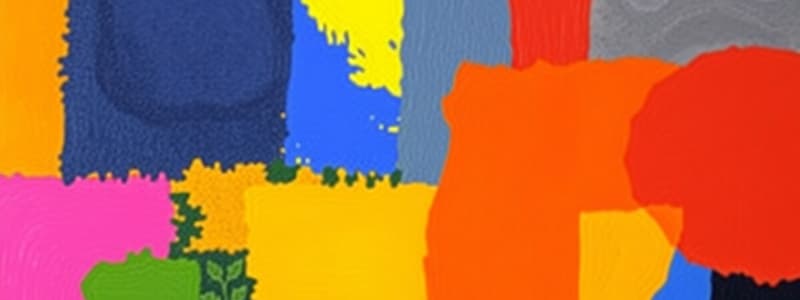Podcast
Questions and Answers
What is the primary feature of the image described?
What is the primary feature of the image described?
- It includes informative text.
- It contains detailed illustrations.
- It has a colorful background.
- It is entirely blank. (correct)
Which of the following statements accurately reflects the content provided?
Which of the following statements accurately reflects the content provided?
- The image serves as a diagram.
- The image presents complex information.
- The image depicts a complex scene.
- The image lacks any visual elements. (correct)
What can be inferred about the image based on the provided content?
What can be inferred about the image based on the provided content?
- It requires additional context to understand.
- It is a visual representation of data.
- It may serve as a placeholder.
- It conveys no information at all. (correct)
What type of content is typically expected from an image?
What type of content is typically expected from an image?
Which of the following best describes the implications of a blank image in communications?
Which of the following best describes the implications of a blank image in communications?
What could be a possible interpretation of a blank image in a communication context?
What could be a possible interpretation of a blank image in a communication context?
Which of the following best explains why a blank image might be used?
Which of the following best explains why a blank image might be used?
In what scenario might a blank image be considered effective?
In what scenario might a blank image be considered effective?
What might a blank image indicate about the creator's intent?
What might a blank image indicate about the creator's intent?
Which statement about blank images is most accurate?
Which statement about blank images is most accurate?
What could be a potential reason for the use of a blank image in communication?
What could be a potential reason for the use of a blank image in communication?
In what context might a blank image be considered acceptable?
In what context might a blank image be considered acceptable?
What emotional response might a blank image evoke in viewers?
What emotional response might a blank image evoke in viewers?
Which scenario is least likely to benefit from the inclusion of a blank image?
Which scenario is least likely to benefit from the inclusion of a blank image?
What is a common misconception about blank images in communication?
What is a common misconception about blank images in communication?
What is the primary purpose of the 'Hook' in a presentation?
What is the primary purpose of the 'Hook' in a presentation?
In the Competing Values Framework, which culture focuses on team development and interpersonal relations?
In the Competing Values Framework, which culture focuses on team development and interpersonal relations?
Which organizational culture is geared towards innovation and continuous improvement?
Which organizational culture is geared towards innovation and continuous improvement?
What type of leader is most suitable for a Market Culture?
What type of leader is most suitable for a Market Culture?
Which key characteristic is associated with the Hierarchy Culture?
Which key characteristic is associated with the Hierarchy Culture?
What is a common trait of leaders required in an Adhocracy Culture?
What is a common trait of leaders required in an Adhocracy Culture?
What role does the 'Took' play in a presentation?
What role does the 'Took' play in a presentation?
Which of the following best describes the key focus of the Market Culture?
Which of the following best describes the key focus of the Market Culture?
What distinguishes persuasion from influence?
What distinguishes persuasion from influence?
Which thinking mode is associated with the central route of processing?
Which thinking mode is associated with the central route of processing?
Which of the following describes the nature of thoughts processed via the peripheral route?
Which of the following describes the nature of thoughts processed via the peripheral route?
In what context is the principle of reciprocity typically applied?
In what context is the principle of reciprocity typically applied?
What is the impact of the central route compared to the peripheral route in terms of persistence?
What is the impact of the central route compared to the peripheral route in terms of persistence?
Which principle of influence suggests that people should act consistently with their commitments?
Which principle of influence suggests that people should act consistently with their commitments?
What effect does the principle of scarcity have on people's perception?
What effect does the principle of scarcity have on people's perception?
Which type of culture focuses on innovation and continuous improvement?
Which type of culture focuses on innovation and continuous improvement?
What aspect is the primary focus of Hierarchy Culture?
What aspect is the primary focus of Hierarchy Culture?
Which culture is associated with energizing employees and emphasizing competition?
Which culture is associated with energizing employees and emphasizing competition?
In a Clan Culture, what is a primary characteristic of the leadership style?
In a Clan Culture, what is a primary characteristic of the leadership style?
What is a vital element of the 'Took' in a presentation?
What is a vital element of the 'Took' in a presentation?
Which leadership style is most effective in an Adhocracy Culture?
Which leadership style is most effective in an Adhocracy Culture?
Which factor is essential in understanding the Organizational Culture and Assessment Instrument?
Which factor is essential in understanding the Organizational Culture and Assessment Instrument?
What does the Clan Culture primarily promote?
What does the Clan Culture primarily promote?
What is the main distinction between the Central Route and Peripheral Route in thinking?
What is the main distinction between the Central Route and Peripheral Route in thinking?
Which principle of influence suggests that people are likely to follow requests made by an authority figure?
Which principle of influence suggests that people are likely to follow requests made by an authority figure?
What does the principle of scarcity imply about people's behavior towards items perceived as rare?
What does the principle of scarcity imply about people's behavior towards items perceived as rare?
In terms of resistance and persistence, how do the Central and Peripheral routes differ?
In terms of resistance and persistence, how do the Central and Peripheral routes differ?
Which statement accurately reflects the relationship between influence and persuasion?
Which statement accurately reflects the relationship between influence and persuasion?
Flashcards
Empty Image
Empty Image
A visual representation that contains no data or information.
Visual Representation
Visual Representation
A way of showing information using images or graphics.
Data
Data
Information, facts, or statistics.
Information
Information
Signup and view all the flashcards
Graphics
Graphics
Signup and view all the flashcards
Blank Image
Blank Image
Signup and view all the flashcards
Visual Absence
Visual Absence
Signup and view all the flashcards
Empty Visual
Empty Visual
Signup and view all the flashcards
Null Representation
Null Representation
Signup and view all the flashcards
Visual Void
Visual Void
Signup and view all the flashcards
Empty Image
Empty Image
Signup and view all the flashcards
Visual Representation
Visual Representation
Signup and view all the flashcards
Data in the Image
Data in the Image
Signup and view all the flashcards
No Image Content
No Image Content
Signup and view all the flashcards
Visual Void
Visual Void
Signup and view all the flashcards
Influence vs. Persuasion
Influence vs. Persuasion
Signup and view all the flashcards
Central Route Processing
Central Route Processing
Signup and view all the flashcards
Peripheral Route Processing
Peripheral Route Processing
Signup and view all the flashcards
Social Proof: 'When Others Are Doing It, You Should, Too.'
Social Proof: 'When Others Are Doing It, You Should, Too.'
Signup and view all the flashcards
Liking: 'When You Like the Source, Do What Is Requested.'
Liking: 'When You Like the Source, Do What Is Requested.'
Signup and view all the flashcards
Authority: 'When the Source Is An Authority, You Can Believe It.'
Authority: 'When the Source Is An Authority, You Can Believe It.'
Signup and view all the flashcards
Reciprocity: 'When Someone Gives You Something, You Should Give Something Back.'
Reciprocity: 'When Someone Gives You Something, You Should Give Something Back.'
Signup and view all the flashcards
Competing Values Framework
Competing Values Framework
Signup and view all the flashcards
Clan Culture
Clan Culture
Signup and view all the flashcards
Adhocracy Culture
Adhocracy Culture
Signup and view all the flashcards
Market Culture
Market Culture
Signup and view all the flashcards
Hierarchy Culture
Hierarchy Culture
Signup and view all the flashcards
Leader Type for Clan Culture
Leader Type for Clan Culture
Signup and view all the flashcards
Leader Type for Adhocracy Culture
Leader Type for Adhocracy Culture
Signup and view all the flashcards
Leader Type for Market Culture
Leader Type for Market Culture
Signup and view all the flashcards
Social Proof
Social Proof
Signup and view all the flashcards
Liking
Liking
Signup and view all the flashcards
Study Notes
No Information Provided
- No information was provided for study notes.
Studying That Suits You
Use AI to generate personalized quizzes and flashcards to suit your learning preferences.
Description
Test your skills in image analysis with this quiz. You will answer questions about the primary features, content implications, and expectations when interpreting images. Challenge yourself to think critically about visual communication.



